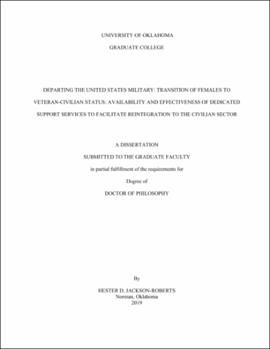| dc.contributor.advisor | Kisamore, Jennifer | |
| dc.contributor.author | Jackson-Roberts, Hester | |
| dc.date.accessioned | 2019-05-10T13:31:59Z | |
| dc.date.available | 2019-05-10T13:31:59Z | |
| dc.date.issued | 2019-05-10 | |
| dc.identifier.uri | https://hdl.handle.net/11244/319675 | |
| dc.description.abstract | In 1948, Congress passed the Women’s Armed Services Integration Act granting women permanent status in the military, entitling them to veterans’ benefits. The purpose of the current study is to identify resources and earned benefits that facilitate or impede the successful transition of women veterans to civilian status. The current study builds upon a model developed by Burkhart and Hogan (2015), by specifically investigating resources and benefits that are key to successful transition from the military beginning with planning of the departure until one achieves full reintegration as a veteran-civilian.
A two-part study was conducted to determine female veterans’ perceptions regarding the role support resources and benefits played in their transition from military to civilian life. The study also examined how the lack of specific resources hindered the transition of some female veterans to feel fully integrated into civilian society. The first part of the study was survey-based to collect demographic information regarding participants’ military service and their utilization of veterans’ benefits and resources. There was a total of 131 viable responses from participants. The second part of the study entailed the conduct of telephone interviews; a total of 52 telephone interviews were conducted.
The results of the survey indicated the respondents utilized the VA benefits they were authorized to receive. Employment, housing and mental and physical healthcare were recurring themes in terms of areas of greatest support used. The Burkhart and Hogan (2015) model did address the medical situation of female veterans; however, the model did not examine resources female veterans need to manage their transition. The current study fills this gap regarding the female veteran transition experience. Results are expected to directly benefit female veterans who are transitioning or who will transition in the future by providing insight into the challenges faced by the participants. It also illustrates how the use of resources and benefits, prior to and after departure from the military can alleviate some of the stressors associated with transitioning from the military to the civilian sector. Additionally, results of the current study can help inform military administration as well as ancillary helping agencies and civilian employers regarding additional support needs for female veterans during the transition process. | en_US |
| dc.language | en_US | en_US |
| dc.subject | Military transition | en_US |
| dc.subject | female veterans | en_US |
| dc.subject | military transition resources | en_US |
| dc.subject | female veteran transition challenges | en_US |
| dc.title | DEPARTING THE UNITED STATES MILITARY: TRANSITION OF FEMALES TO VETERAN-CIVILIAN STATUS: AVAILABILITY AND EFFECTIVENESS OF DEDICATED SUPPORT SERVICES TO FACILITATE REINTEGRATION TO THE CIVILIAN SECTOR | en_US |
| dc.contributor.committeeMember | Day, Eric | |
| dc.contributor.committeeMember | Worley, Jody | |
| dc.contributor.committeeMember | Gullberg, Steven | |
| dc.contributor.committeeMember | Morgan, Meg | |
| dc.date.manuscript | 2019-05-08 | |
| dc.thesis.degree | Ph.D. | en_US |
| ou.group | Graduate College | en_US |
| shareok.orcid | 0000-0022-6951-1891 | en_US |
